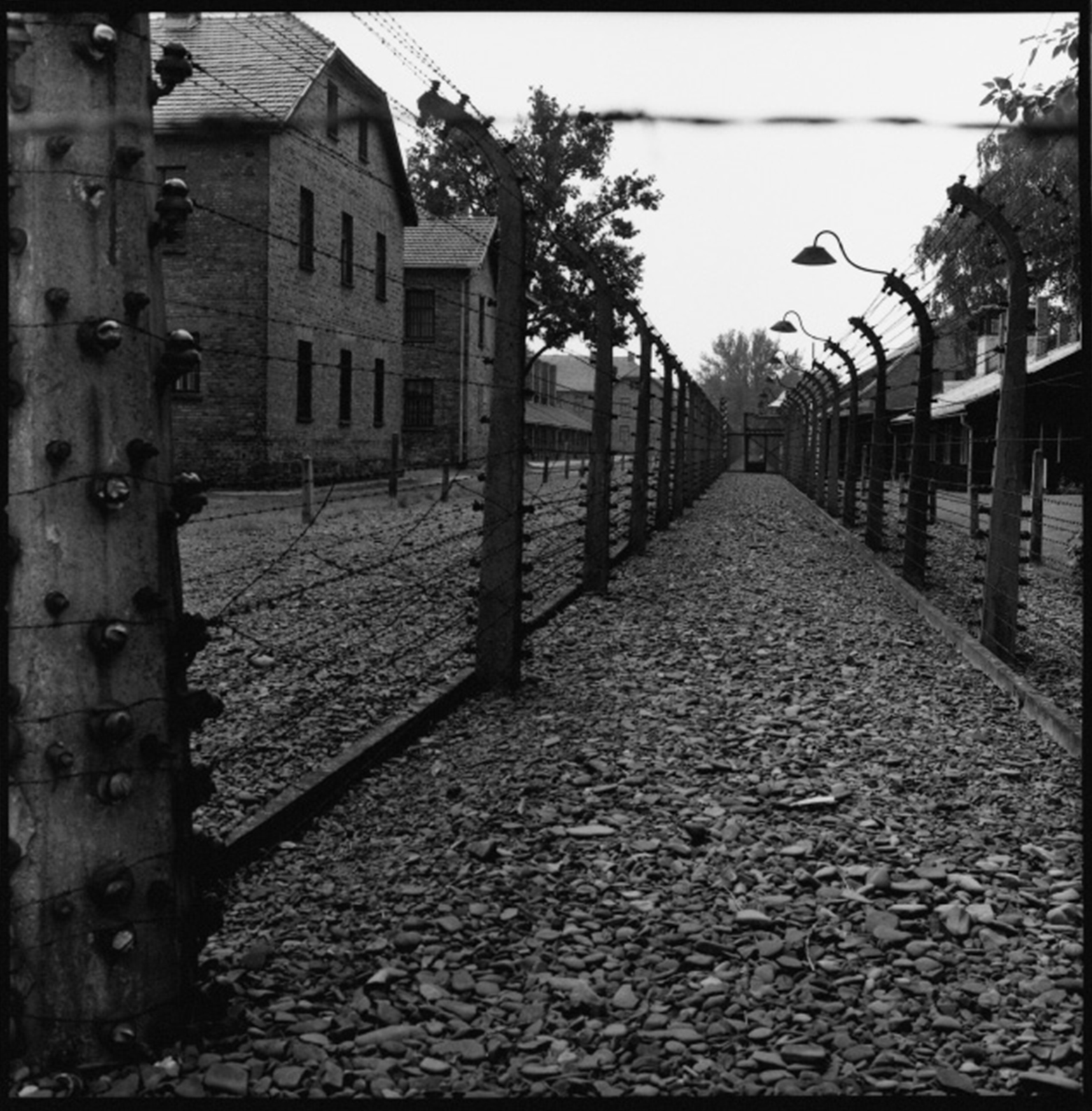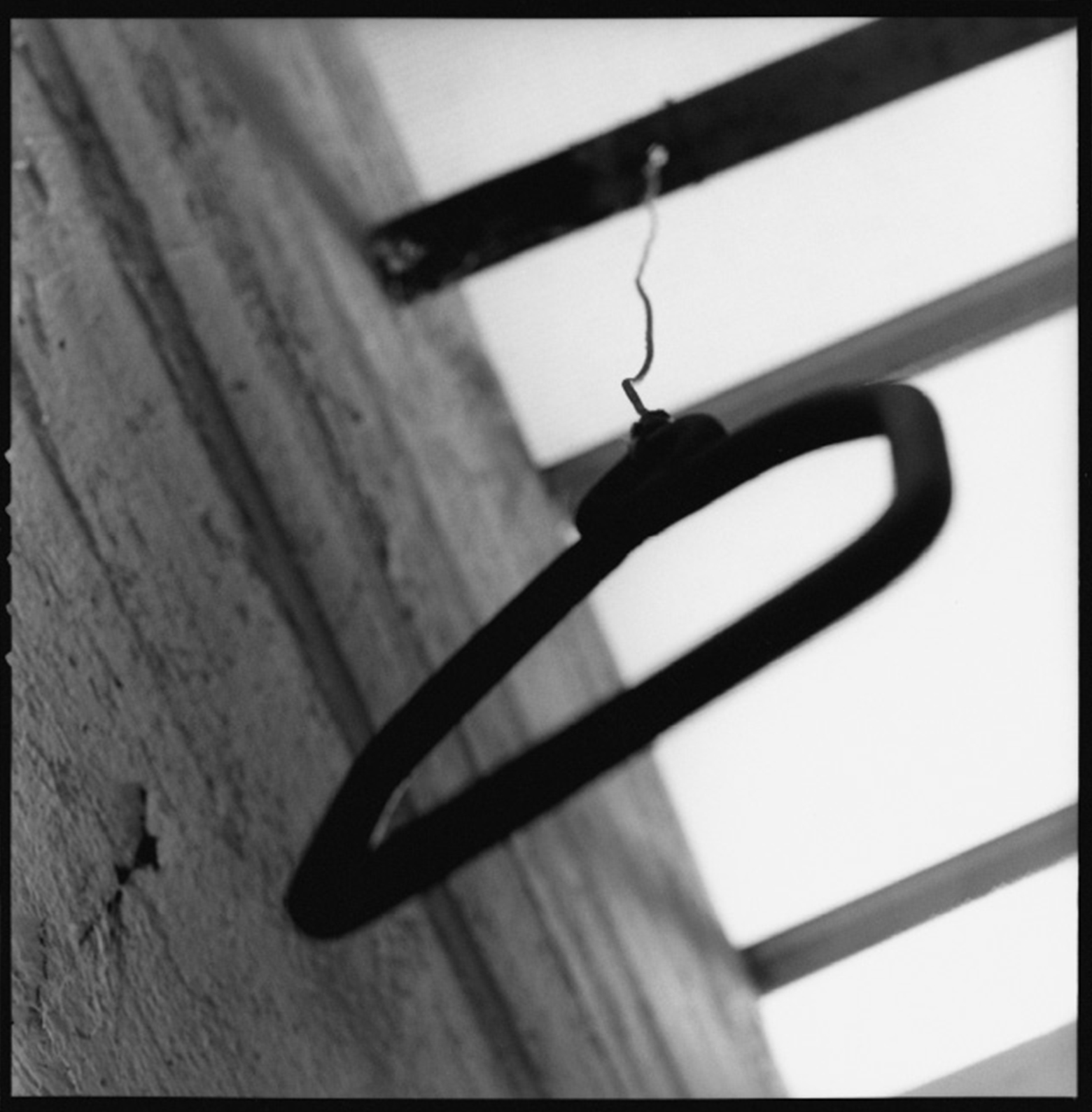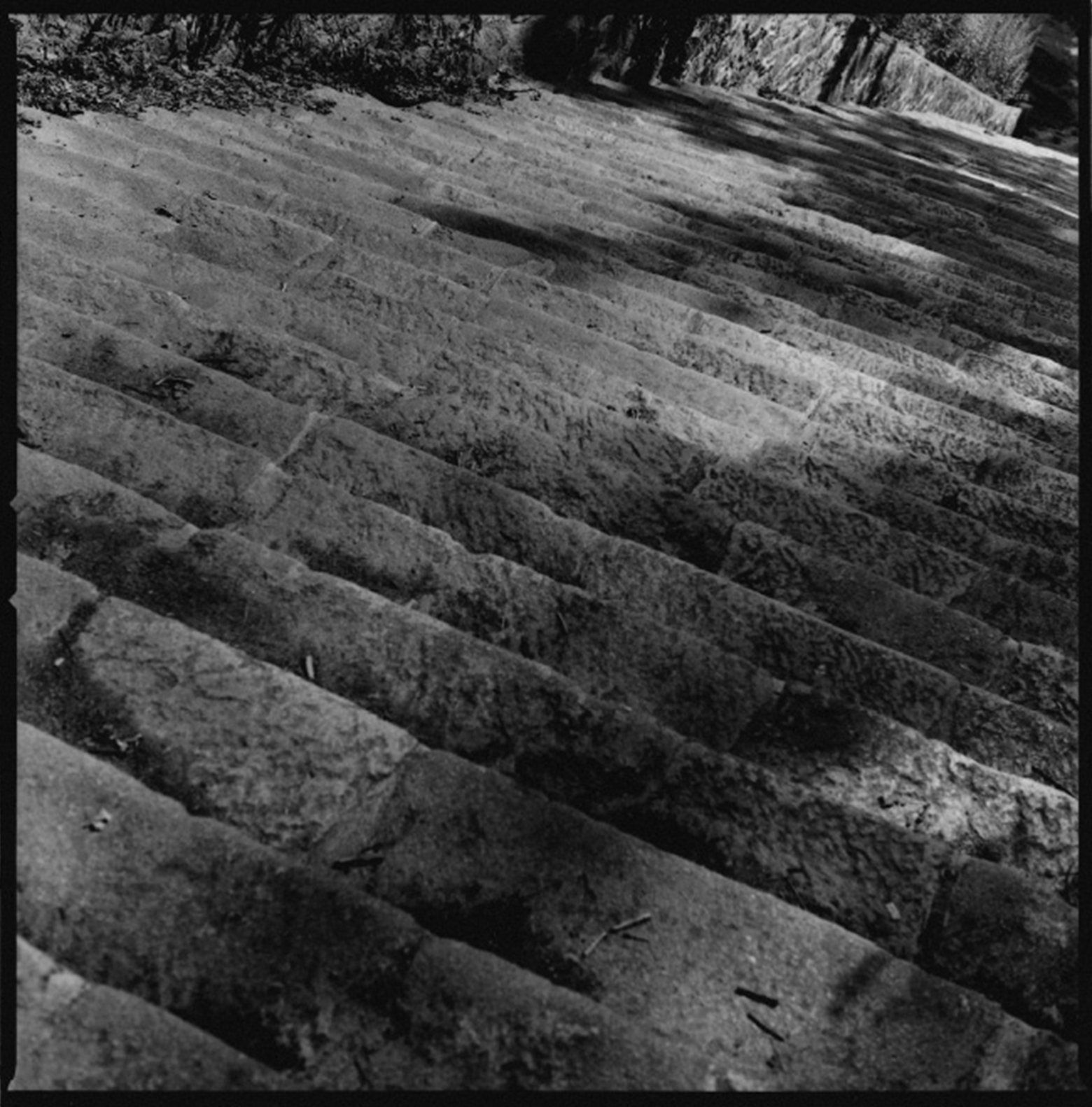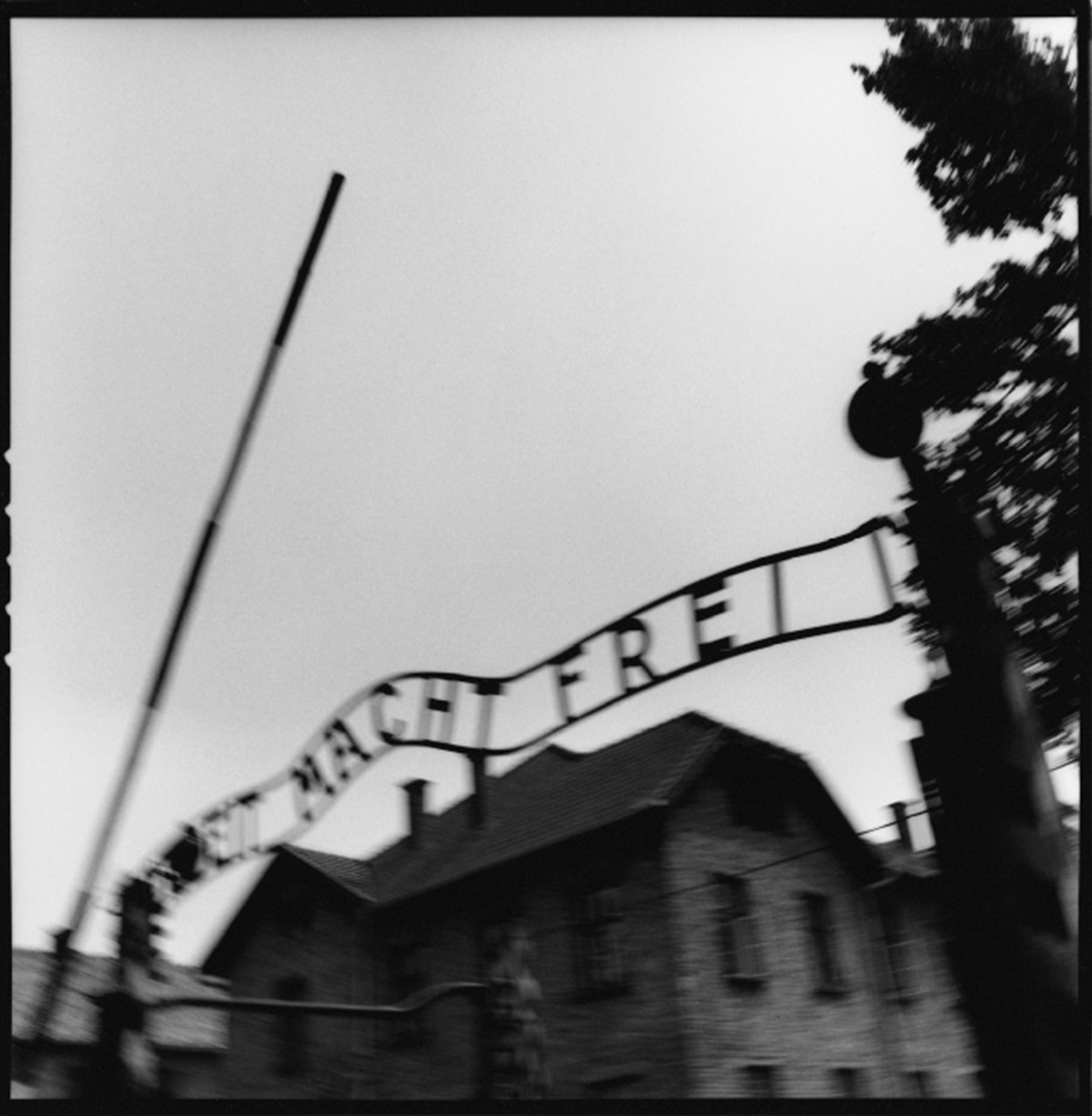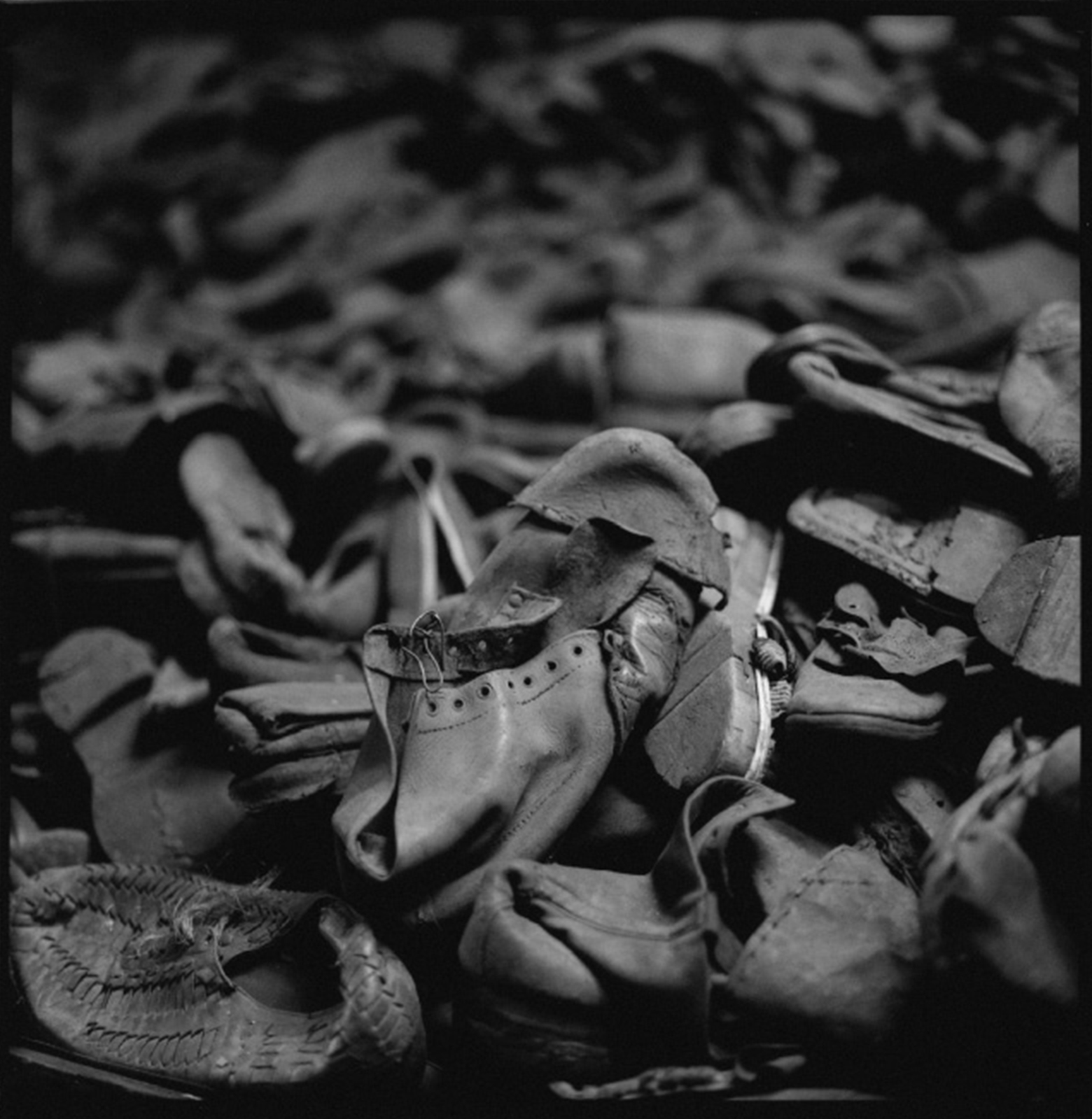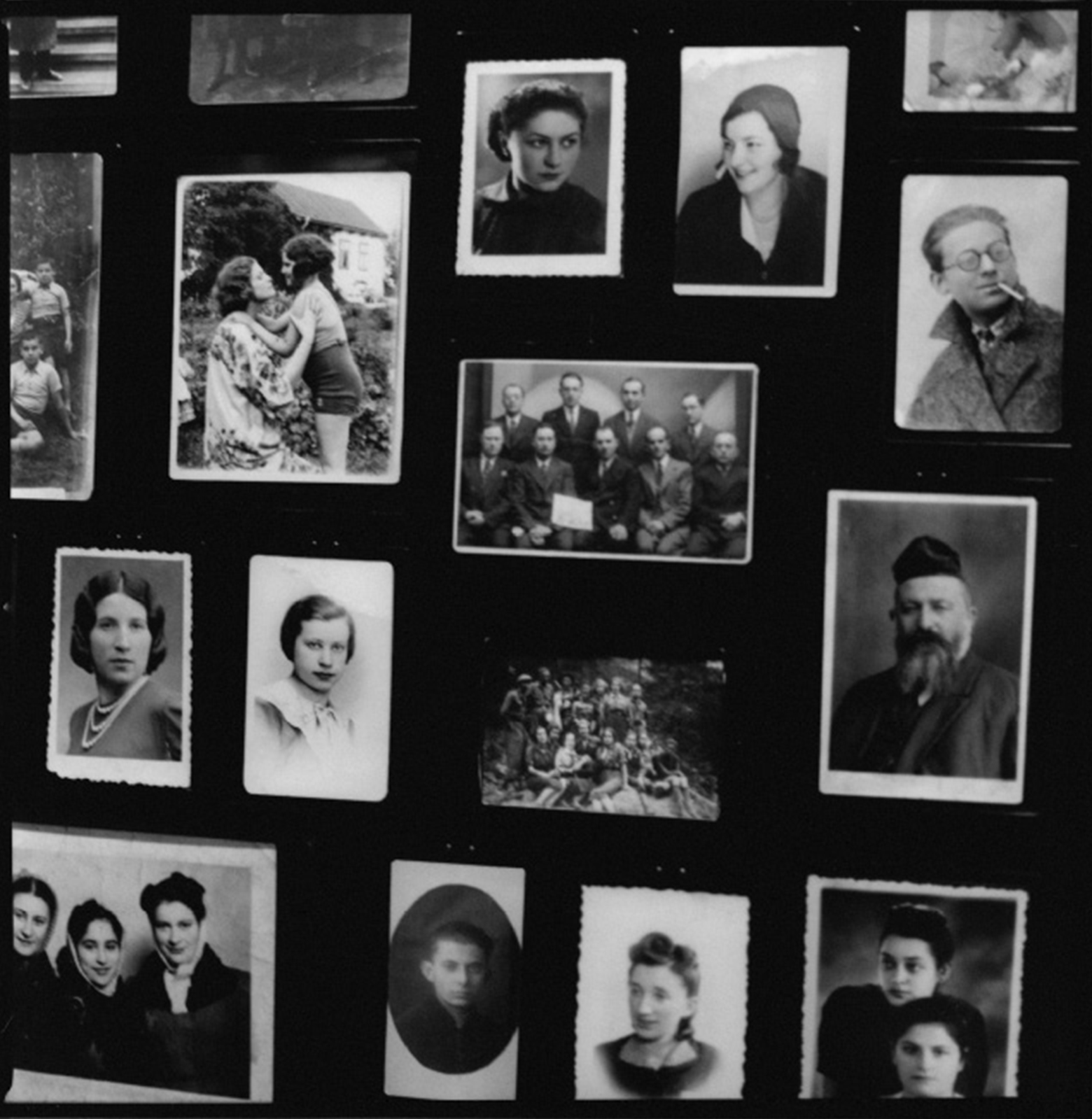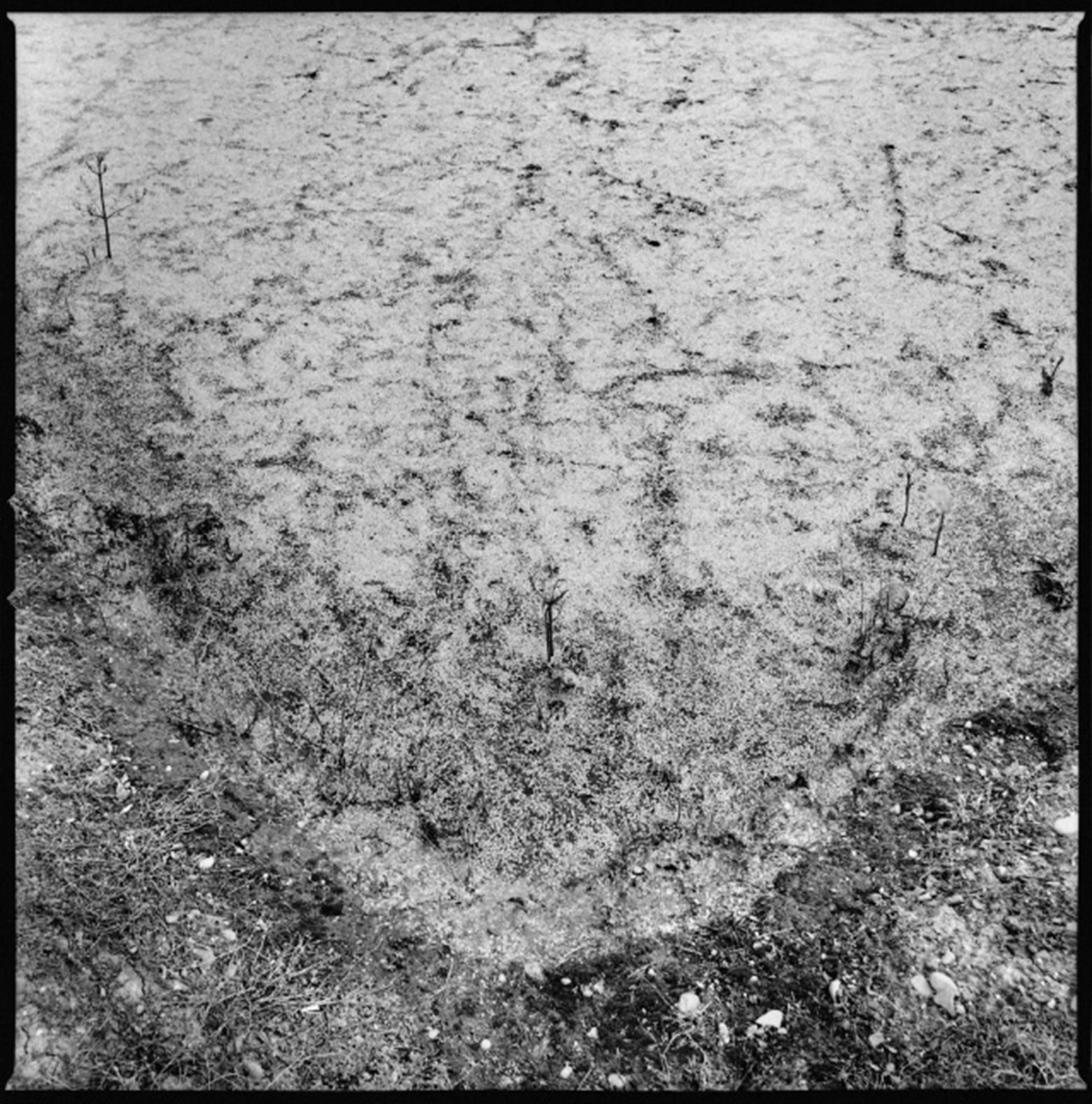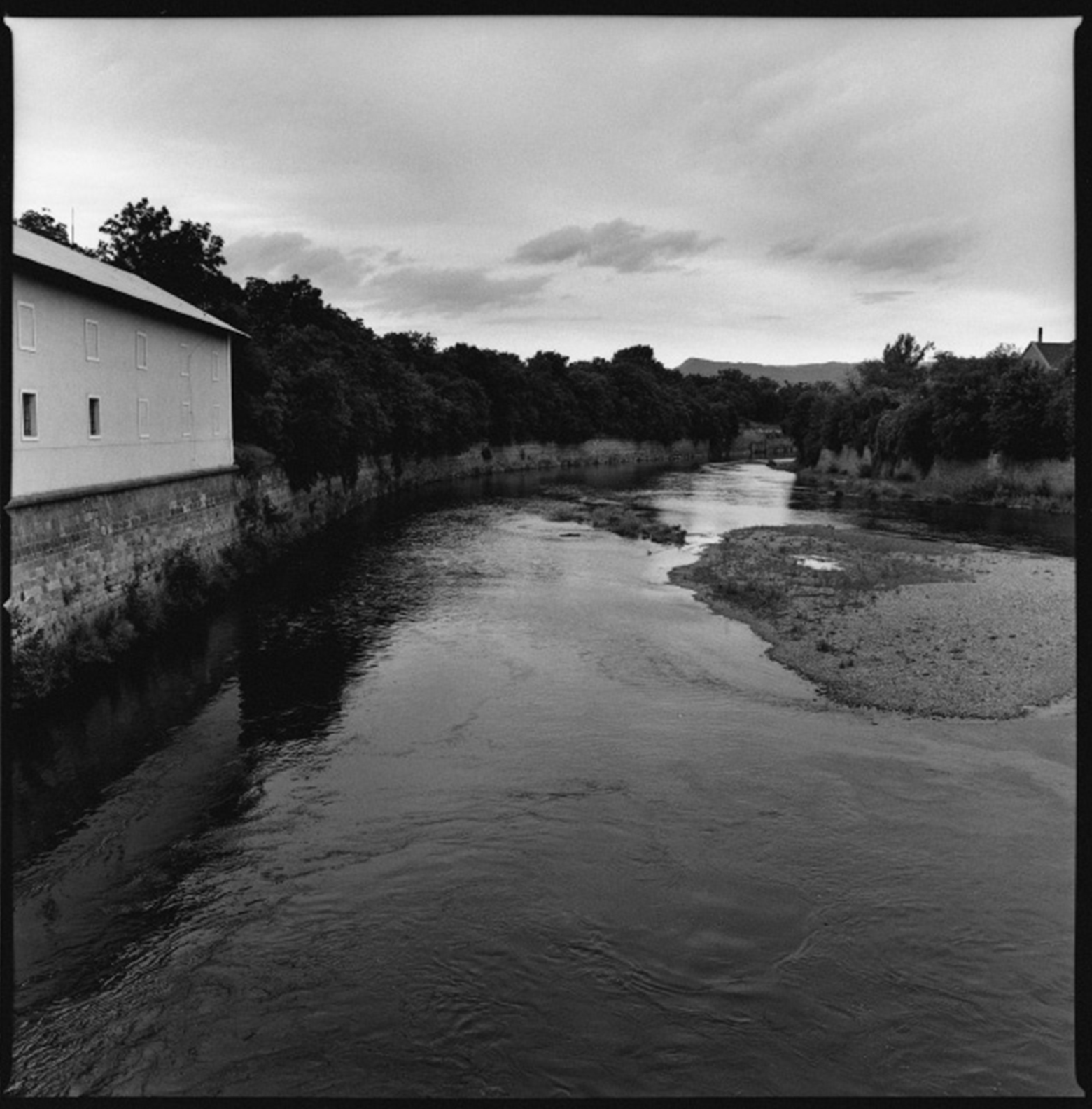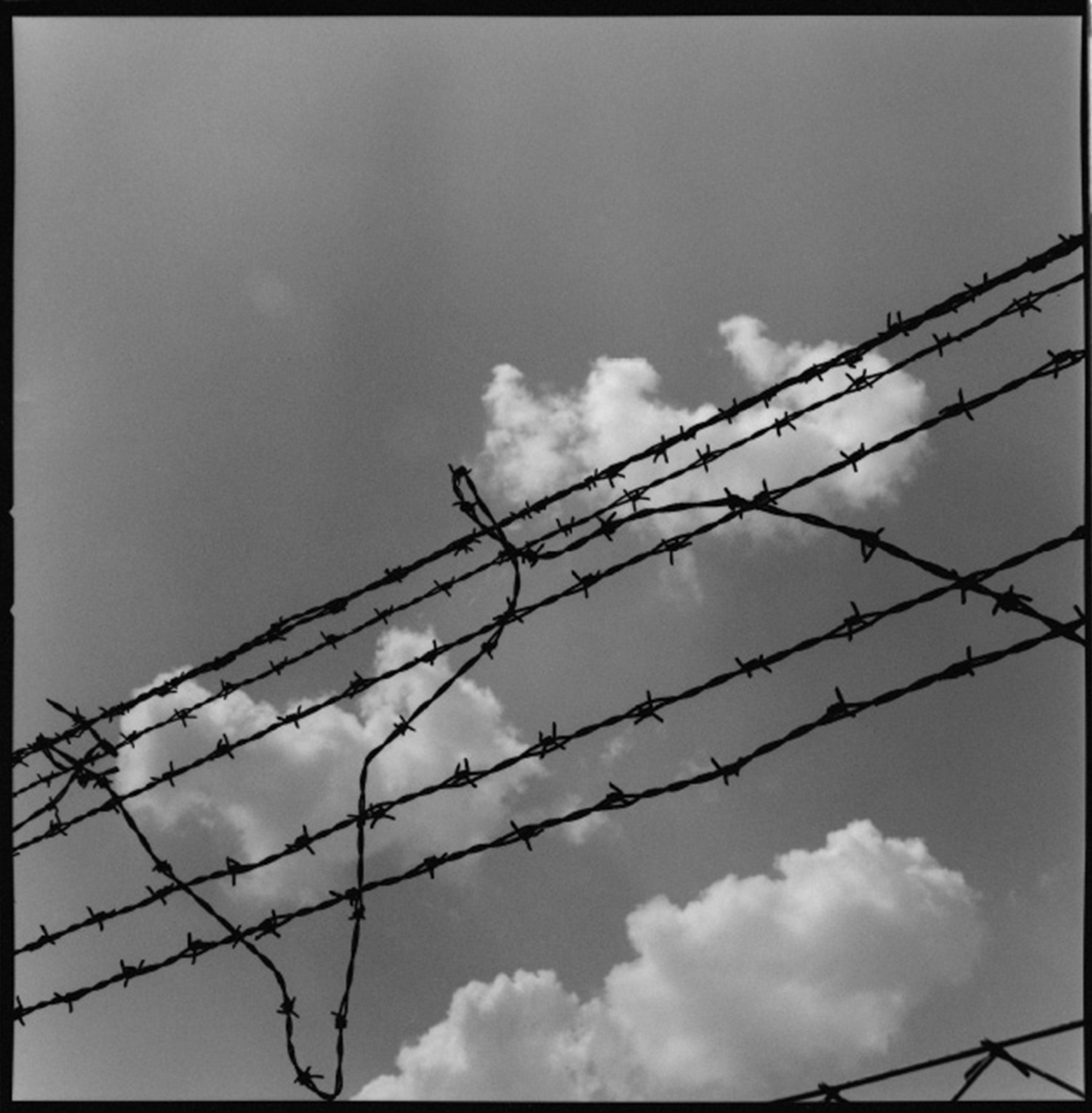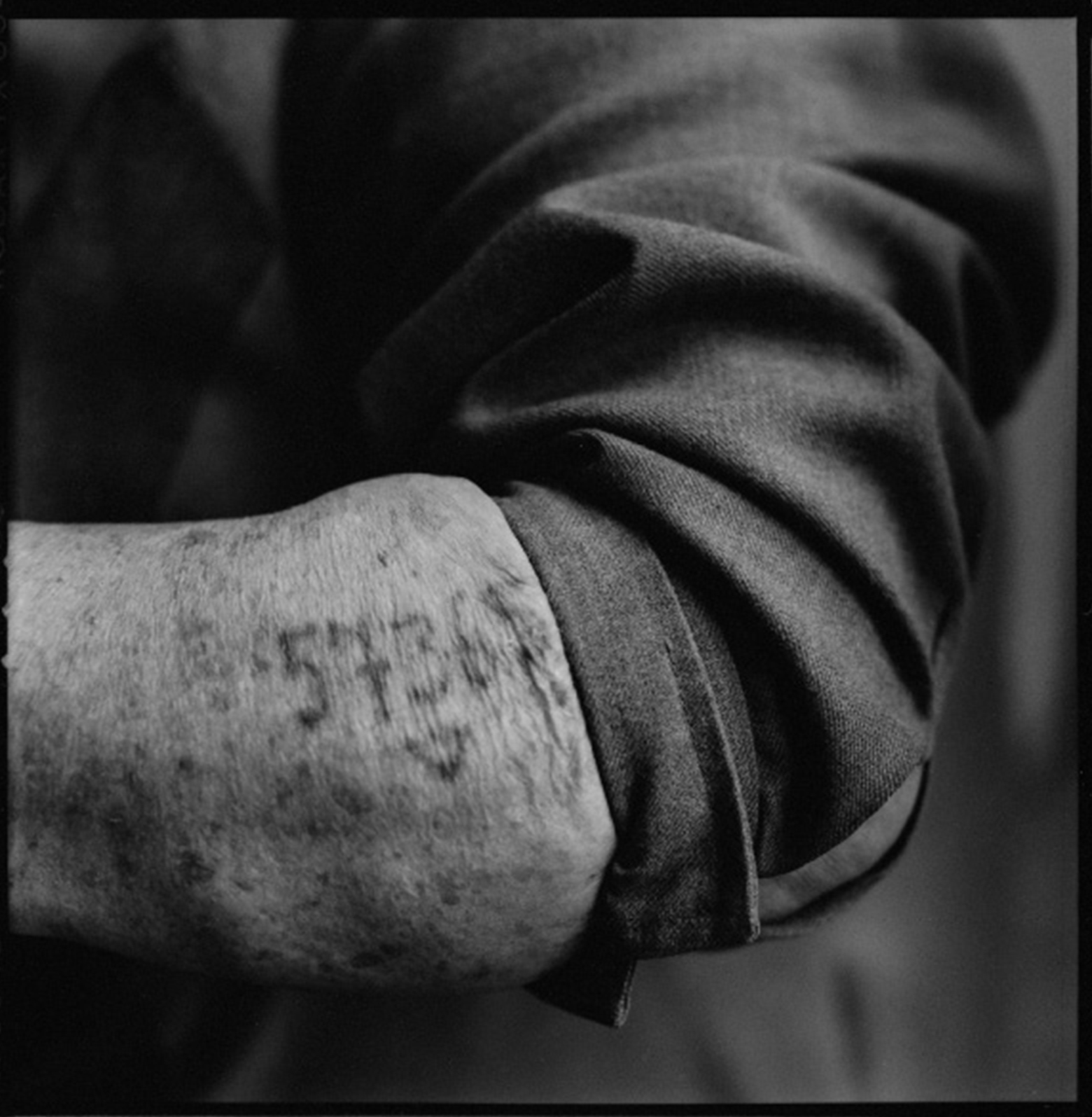I take a trip to central Europe to see some of the concentration camps my survivor friends have told me about. I bring along a lot of film, some sturdy walking shoes, my husband, Eddie, and a heart that is poised for breaking.
Our first stop is Dachau. It’s hot. The pavement radiates a thick, heavy, suffocating heat. There are many visitors. We pour out of the bus that has carried us from Munich, guidebooks and maps in hand. We trudge to the entrance together. Several people hold wads of Kleenex.
The barbed wire looks like stars stretched across the sky, rising just above the foliage. The vegetation is dense and very green. It is lovely. Paths lead to beautiful spots of repose in the woods where markers describe the views: execution wall, blood ditch, buried ashes.
A prisoner’s uniform is displayed in the museum. I try to think of anything other than who might have actually worn this uniform, whose callused feet might have slipped in and out of the wooden clogs before and after a long day of forced labor in this camp. I imagine the pants draped over a chair in a beautiful woman’s bedroom. I see a man disrobing, approaching the arms of his waiting lover, the bedsheets crisp and clean, the room dark, except for the quiet light of early evening coming in through the window.
I learn that, from the beginning, the Nazis had problems disposing of their victims’ bodies. Those that were thrown into mass graves often swelled so much during the summer months that they resurfaced. They kept haunting their killers and had to be reburied. That’s when the Nazis decided to build the crematoriums. Dachau’s were special because several corpses could be burned in them at the same time.
I see a toddler with a pinwheel standing at the entrance to the crematorium. Every now and then, she waves it in the air, and the plastic colors start to spin around. Her mother takes her by the hand, and the two of them turn and stand in front of the oven, staring.
I wonder what the mother is saying to her little girl.
Mauthausen concentration camp is located just outside of Linz in upper Austria. Linz is a quiet little town, quaint and charming. Only a few kilometers from this idyllic Austrian village is a place that was renowned for its cruel and brutal working conditions and for the deliberate extermination of its occupants.
I descend the cement steps and enter the gas chamber. It takes a few seconds for my eyes to adjust to the darkness. It looks as if the Nazis cleared out a few minutes ago and the place could be made operational with just a quick turn of a crank or the lowering of a heavy lever. Nobody is down here but me. I start to feel short of breath, as if someone has just kicked me in the stomach.
After a while, I start to hear the screams.
I remember reading that, during the gassings, the victims would climb on top of one another to get to the quickly disappearing fresh air above. When the doors were opened after the allotted twenty minutes, dead families were found huddled together, sometimes still holding hands. Mostly what I remember, though, is that the children were usually found on the bottom of the heap, because the adults had tried to scratch their way to the top.
Sometimes the Nazis would tire of hearing the screams and would back their trucks up to the gas chamber, turn on the engines, and sit. This way they wouldn’t be bothered by the noise.
It’s hot. The sun is blinding. I shade my eyes and look around at each barrack and building. I enter a room that was used for hangings. The ceiling resembles a skylight. The sun pours in and washes the walls. I learn that prisoners were strung up on metal stirrups, one of which is still dangling lazily in the sun. It looks as if it is suspended from another world. I imagine the prisoners standing there, being forced to watch someone hanged for speaking out of turn, for not cleaning his boots, for sharing food with a family member, for looking pale. The sun would have been bright. They would have seen the victim’s head drop and his eyes roll back. They would’ve seen it clearly, as if he were lit by a spotlight on a stage.
I wander past the monuments and memorials toward the quarry and find the “staircase of death.” Here prisoners were forced to carry granite stones weighing more than 100 pounds up 186 steps. This meant death for anyone who lost his footing. The Nazis made a game out of it. They would place bets on who they thought would get to the top of the steps first. The laborer who did was then commanded to jump to his death from the stone cliff nearby. Guards also seemed to enjoy pushing laborers down the stairs.
I stand on a step midway down and try to imagine it. Of course, I cannot.
More than one hundred thousand people died here. There were inmates and prisoners of war from almost every European nation, put here for their political, racial, and religious identities, as well as those who were persecuted for unacceptable sexual preferences.
There is barbed wire everywhere. The SS used to entertain themselves, I am told, by forcing prisoners to run full speed into the sharp fences, then shooting them as escapees. I imagine the guards in charge laughing and joking, shouting out self-congratulations as they pick off the prisoners one by one, as if in a shooting gallery at a carnival.
Even the commandant’s twelve-year-old son was allowed to shoot prisoners. He did this from his family’s front porch.
I think of my son, Max. He’s twelve, too. He’s at summer camp learning to tie slipknots and eating homemade ice cream.
Eddie puts on his yarmulke as we enter the parking lot at Auschwitz. This place is considered the cemetery of the Jewish people. The largest mass murder ever in human history happened in this twenty-five-square-mile area. At least 1.5 million people were murdered here, 90 percent of them Jews.
There is a hot dog and ice-cream stand to the left of the parking lot. The lot itself is crammed full of buses. People are laughing and taking pictures of each other. We could just as well be at Epcot Center or the Eiffel Tower. The sign above the gate reads, “Work Makes You Free.”
Looking around at Auschwitz is like being at the Smithsonian. The tale is neatly told with sterile, glassed-in exhibits, spruced-up buildings, and grounds that resemble a college campus. Nonetheless, it’s horrifying. There are glass cases full of items that once belonged to the murdered victims. They were discovered by the Soviets upon liberation of the camp. There are eyeglasses, prayer shawls, suitcases, prosthetic limbs, shoes.
The shoes get to me the most. The shoe display is higher than I am tall and fills a room three times larger than my living room. There are all different sizes and styles. Some of the shoes are flattened and crushed. Others look as if someone has just slipped out of them, as if maybe they have been left at the front door because they are too muddy and will leave tracks on the carpet.
Birkenau, or Auschwitz II, is two and a half miles away. The trail between the two camps is often referred to as “Death March Road.” Birkenau means “birch-tree woods.” It was built as an extermination camp.
The Nazis used to tell the prisoners upon their arrival in Birkenau that the only way out was through the chimneys. I spend two days wandering there. I feel numb. An exhibit displays the victims’ family photos. The air is filled with ghosts.
I learn that it took only twenty minutes for a newly arrived group of Jews to be undressed, gassed, and stripped of hair, gold fillings, and jewelry before being taken to the crematorium. At the height of operation, as many as twelve thousand bodies were burned each day. Their ashes were plowed into the soil and dumped into ponds.
At the large “pond of human ashes,” I tiptoe silently around the edges, trying to photograph it with great respect. At some point, though, I sink into the water. It’s very much like a swamp, and as hard as I try, I cannot get to dry land. I go deeper and deeper into the pond. At first I am filled with horror. My shoes are soaked. It feels disrespectful and sacrilegious to be there among the ashes. The water is warm. I start to cry.
Then somehow I begin to feel solidly connected to the people I have been trying to imagine all day, the people who are my ancestors. I stand in the water and weep.
Terezin was Hitler’s “gift to the Jews,” his “model ghetto,” a Jewish community established in an eighteenth-century walled fortress thirty miles northeast of Prague. Jews believed they could sit out the war here and escape the death camps in the east. Many elderly Jews arrived with their best clothes, wearing top hats and jewelry, expecting apartments on streets with names like Lake Drive and Paradise Avenue. Admission rights were sold to the privileged and the wealthy. It would be a community for Jews run by Jews. There would even be a special currency there, with a picture of Moses carrying the Ten Commandments.
In reality, Terezin was a stopover on the way to the death camps. A holding tank. At one point, almost sixty thousand people lived in barracks designed to hold seven thousand combat troops.
The population in Terezin was made up primarily of scholars, doctors, actors, artists, writers, intellectuals, composers, and their many children. Of the fifteen thousand children who passed through this place, fewer than one hundred survived. In all, thirty-five thousand people died here. Eighty-seven thousand were sent from here to the death camps.
There was a rich cultural life in Terezin, despite the horrid living conditions, disease, starvation, and constant dread of transport. There were plays, drawing lessons, concerts, lectures. Some of the artwork is on display.
I look at the drawings made by the children. At home my kids’ drawings are taped to the walls and cabinets, hanging from the refrigerator, neatly framed and proudly displayed in the hallways. These could be their drawings. I hold my breath as I study the brush strokes, the pencil marks, the childish scrawls. I read the poems about their life in this horrible ghetto and the better life they look forward to when they leave it.
There were no gas chambers here. The prisoners died by execution, starvation, typhoid. Their corpses were burned in the crematoriums, their ashes dumped in a beautiful river nearby.
A survivor of Terezin tells of games the SS used to play here. One was a shooting-gallery type of game. Prisoners were made to run back and forth along a stone wall while guards placed bets, took aim, and fired at their moving targets. In another game, the SS commanded prisoners to jump into the guards’ swimming pool and float around on their backs while the guards took turns ramming their bodies with clubs.
Some Jews took their own lives, not only here, but at all the camps. One of the easiest methods was running into the electrified barbed-wire fences.
This camp is the most difficult one for me to digest. Perhaps it is because of the guise the Nazis created for unsuspecting Jews. Perhaps it is because of the large number of children who were shipped away from here to their deaths. Maybe it’s because Terezin really looks like a place where people could call out over the backyard fence to a neighbor, where kids could kick a soccer ball down the street.
The site of the Plaszow concentration camp is now a nature preserve, dotted here and there with a few monuments. At one time, this plot of land was a Jewish cemetery and a rock quarry. Then it became a forced-labor camp for the Jews from Krakow. The Nazis ripped up all the tombstones; the granite came in handy for the building of walkways. Later, it became a concentration camp.
Plaszow is well-known because it provided the setting for the movie Schindler’s List. A psychopathic killer named Amon Goeth ran the camp. He liked to shoot Jews for sport from his balcony.
As I walk around the place, I am overcome by its beauty. It is silent and lush and hilly, and there is a gentle wind caressing the long grasses in the meadows. I feel a sense of peace here, a sense of hope. The breeze feels good on my face. I look at the land and consider the regrowth that is all around me.
I think about my friends who survived the Holocaust: Ann and Isak, Tola and Iser, Sigmund, Bronia, Gena and Kate, Lily, Evy and Zdenko. I think about their children and grandchildren, of all the good lives which have come into the world because of them.
And I think of my children. In a few months my son will become a bar mitzvah. My father will pass the Torah to me, and I will pass it on to my son. Another young Jewish man will take his place as a son of the commandments. And so it goes, l’ dor va dor — from generation to generation.

